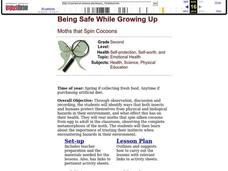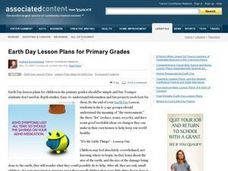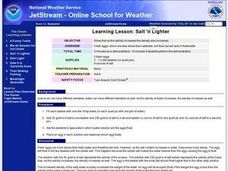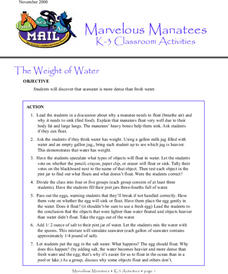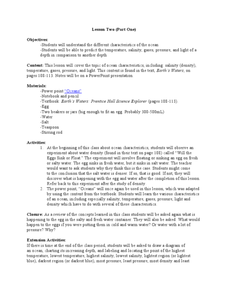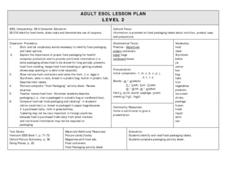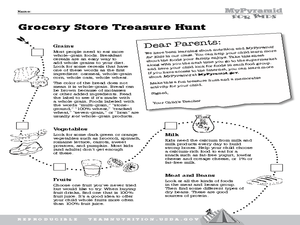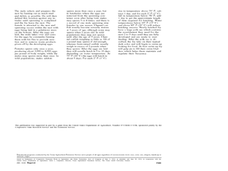Curated OER
Being Safe While Growing Up
Second graders identify ways that both insects and humans protect themselves from physical and biological hazards in their environment. They rear moths from egg to adult and consider the importance of trusting their own instincts.
Garden Earth Naturalist Club
Parts of a Flower! Flower Dissection
Sometimes the best way to learn about plants is to see the different parts of a plant yourself. Groups of learners dissect flowers to answer questions about what they observe and what they wonder about their flower.
Curated OER
Exploring the Properties of Matter in the Preschool
Students study the properties of the physical and natural world. In this properties of the physical and natural world lesson, preschool students work at discovery tables to see how simple machines work, what happens when items are put...
Curated OER
Farming 1: Farming Machines
Second graders explore different farm machines. In this farm lesson, 2nd graders discover the importance of farmers, and crops. Students discuss healthy eating and how crops are packaged. Students read books about farms and how bread is...
Curated OER
Protein - Complete and Incomplete
The relationship between how an individual looks and feels and the nutrients he or she eats. Identify proteins (complete and incomplete), their sources, and functions in the body. National Standard 14.2.1 Define amino acids, complete and...
Curated OER
Earth Day
Students complete a variety of Earth Day activities. For this recycling and the environment lesson, students listen to Earth friendly music, create a car out of juice boxes, use soda cans and bottle caps to create a Halloween...
Curated OER
Learning Lesson: Salt 'n Lighter
Students participate in a demonstration showing that as salinity increases density increases as well. They also examine the different densities of air. They discuss the amount of water displaced by large ships.
Curated OER
PICTURE PERFECT PYRAMID
Students create a model of the USDA's Food Pyramid Guide, using shoe boxes. They bring an assortment of shoe boxes from home. Students are given a copy of the "Food Guide Pyramid." They wrap boxes for the bread group in white, the...
Curated OER
The Weight of Water
Students participate in an experiment about the weight of water. They work together to discover that seawater is more dense than fresh water. They also determine which objects float and sink.
Curated OER
Be an All Star
In this foods worksheet, students find the foods in the picture and circle the foods that are asked of them. Students circle 13 breakfast foods that are in Spanish.
Curated OER
Lesson tow
Students study the ocean and its characteristics. For this oceans lesson students complete a lab activity and are able to predict temperature of certain depths.
Curated OER
ADULT ESOL LESSON PLAN--Level 2--Consumer Education
Students, after reviewing an extensive list of vocabulary terms on the board, identify/label food items, how much they cost and the value of using coupons to save money. In addition, they practice reading the labels on the food packaging...
Curated OER
TIN CAN TREAT
Learners conduct an experiment where they will change a liquid dairy product into a solid. They review the definitions of liquids and solids. Students are given an example of each. They are divided into groups of four, each group is...
Curated OER
Eat Smart with MyPyramid for Kids
Students investigate food examples from the food groups to explore a healthy diet. In this healthy eating lesson, students study the food pyramid and complete related worksheets. Students also play pyramid go fish.
Curated OER
Farming 1: Farm Machines
Students examine how machines help people grow food. They study specialized types of farm machines and the tasks they perform. They complete handouts matching images of the machines with text.
Curated OER
Channel Catfish
Students study the life and biology of the Channel Catfish. In this aquatic biology lesson, students will examine the external and internal features of the catfish along with their breeding habits and environment. This lesson includes...
Curated OER
A Healthy Start To Every Day
Students discuss the importance of having a healthy breakfast to begin their day. Students develop a cause and effect relationship between breakfast and their overall well being. They work cooperatively to plan balanced breakfast menus.
Curated OER
Great British Dishes
Sixth graders examine the different types of famous British dishes. In this British culture lesson, 6th graders research different types of British food. Students create a presentation about Great British food.
Curated OER
Milk and Dairy Test
Students explore how to select and prepare milk and milk products, identify standard serving size for milk and milk products, review terms associated with milk and milk products, and demonstrate knowledge of how to use and care for these...
Curated OER
Science Lesson #2
Fourth graders explore and experiment with objects that float to see if they float differently in salt water or fresh water. After the experiment, they write a paragraph in their science journal explaining how fresh water and ocean water...
Curated OER
The Designed World
Students manage and retrieve numbers and letters that are logically sorted. In this logical information lesson plan, students do the flood game from the PBS website. Students answer questions about library books.
Curated OER
Traditional Food in the United Kingdom
Students read an article that discusses numerous food traditions. In this ESL instructional activity, students work in small groups to complete a vocabulary assignment on the article, a brainstorming activity, writing an essay and...
Curated OER
Natural Dye Lesson Plan
Students investigate major pigments which occur naturally in fruits and vegetables, and to use them to dye a number of items. They study the effects of pH on anthocyanin on pigments.
Curated OER
The Effect of Citrus Oils on Fruit Flies
High schoolers answer the question, "How could citrus fruits be toxic to fruit flies when fruit flies live on fruit?" They conduct an investigation using four different citrus oils and fruit flies and analyze data collected.
